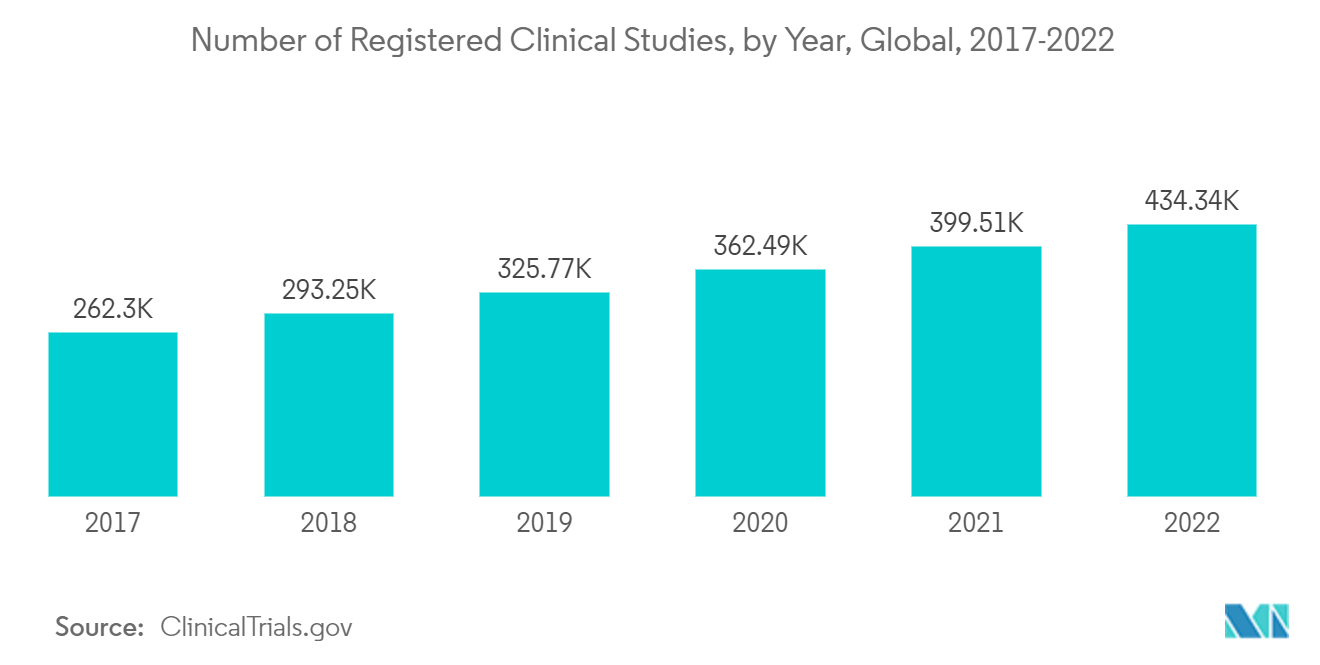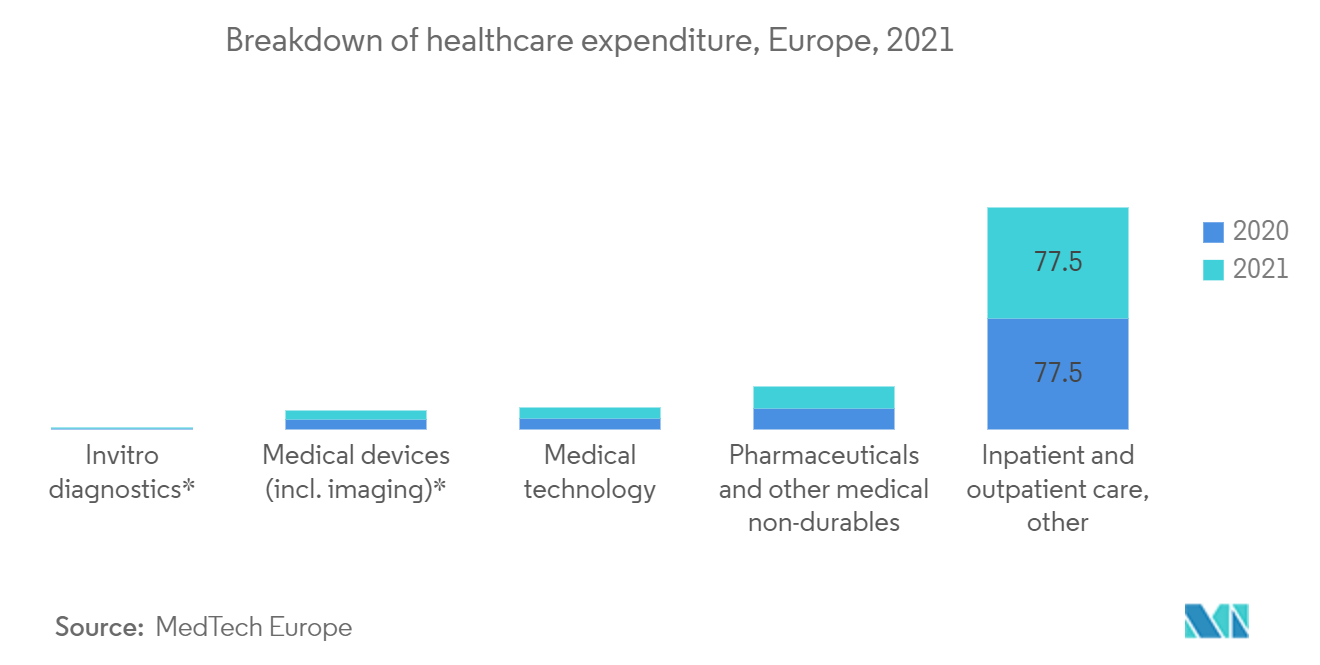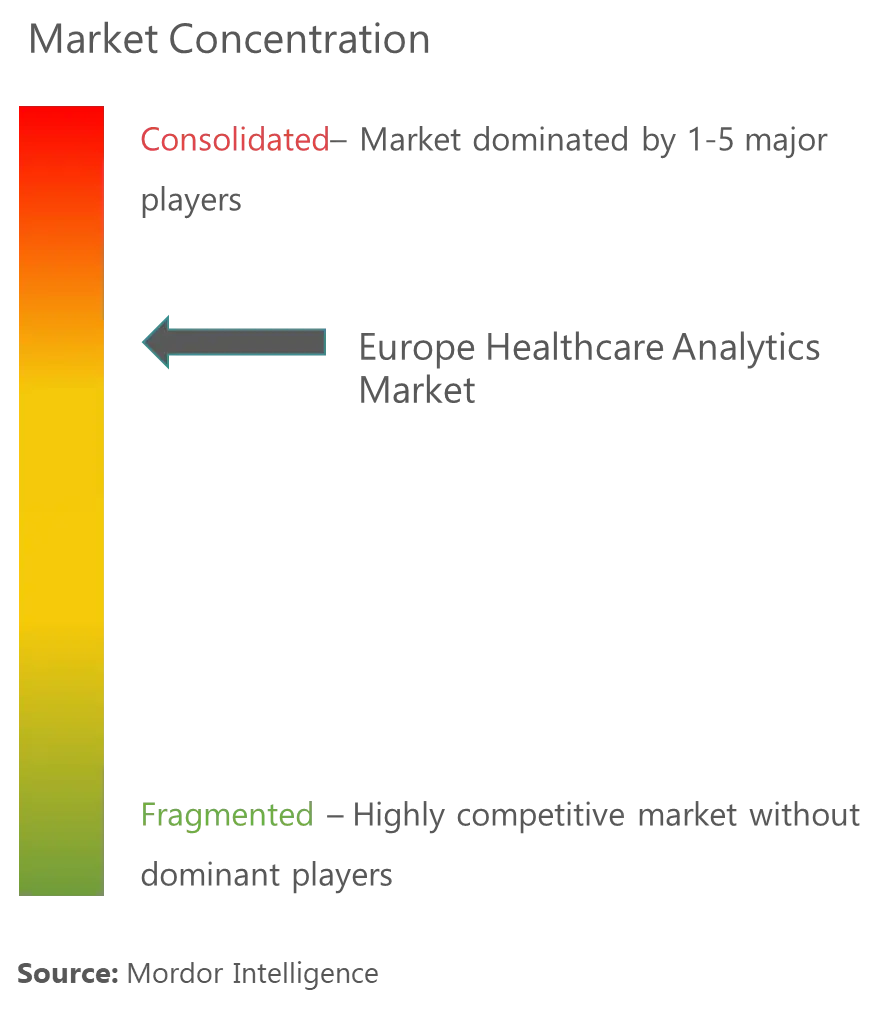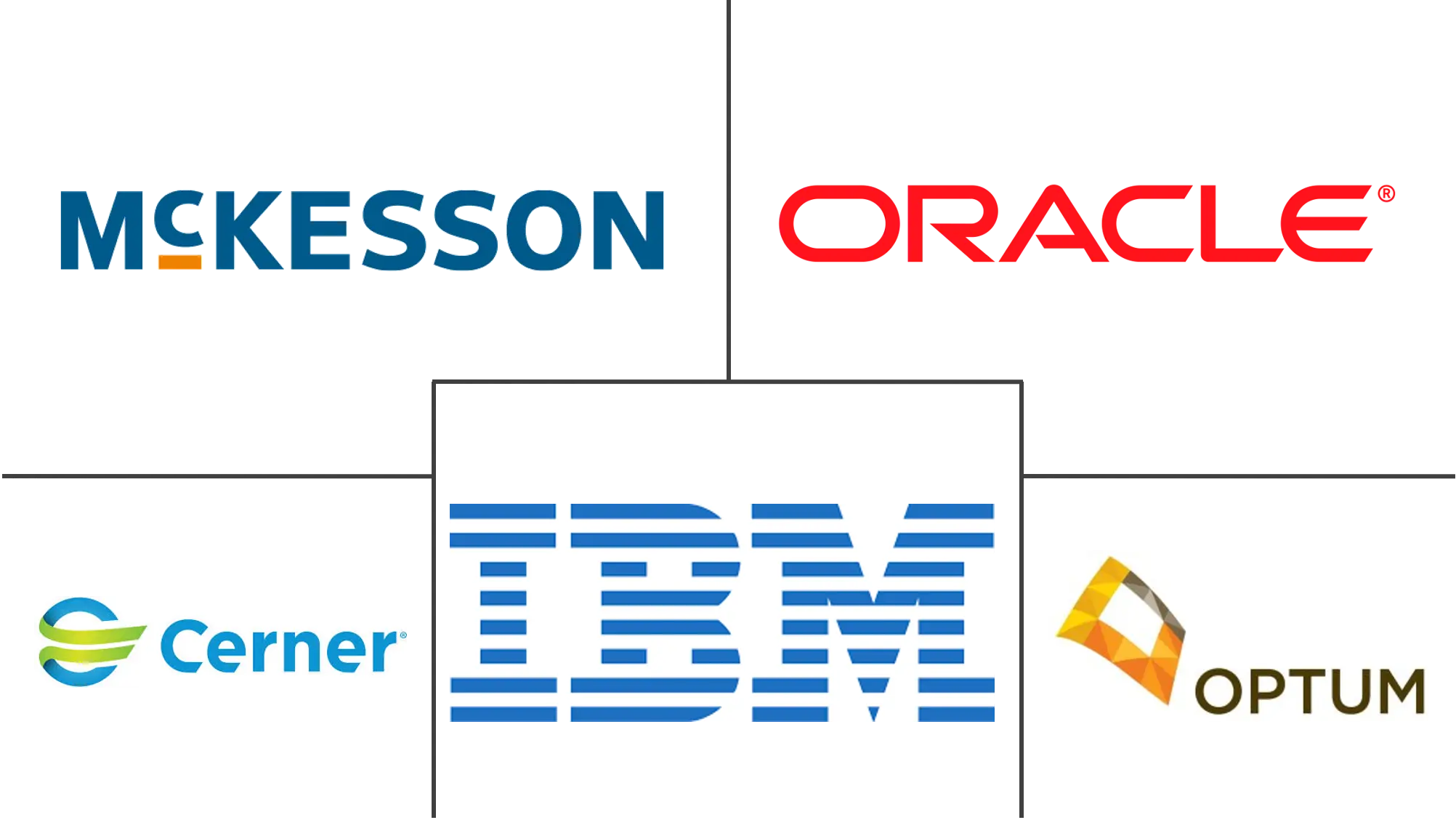
Europe Healthcare Analytics Market Analysis by Mordor Intelligence
The Europe Healthcare Analytics Market is expected to register a CAGR of 19% during the forecast period.
- COVID-19 had a slightly positive impact on the healthcare analytics market, which has been largely attributed to the current focus of pharmaceutical and biotech companies on developing a therapeutic drug or vaccine for COVID-19. Some companies are also conducting clinical trials for their specific drug components. Analytics, which is important in clinical trials and dealing with large databases, has been discovered to be useful in the current situation of the COVID-19 global outbreak.
- With the increasing number of data records in the healthcare sector, the adoption of advanced analytics is increasing to provide data-driven insights faster, which is one of the primary factors driving the market. The market is driven by lower costs for health care and the expectation that emergency services will be needed. Patient patterns and histories can be identified more efficiently with digitized healthcare records. Predictive analytics can isolate patients who may be at high risk of crises due to chronic health problems, allowing physicians to provide corrective plans that decrease emergency visits, thus further reducing the overall cost of resources. With the advent of digital devices such as IoT and applications that are increasingly becoming part of the healthcare system in Europe, various government initiatives to support and incentivize the use of technological solutions in healthcare further boost the demand for data analytics.
- Apart from this, connected devices that generate huge amounts of data are expected to increase significantly; this raw data can be analyzed to make better enterprise decisions. According to European Telecommunications Network Operators (ETNO), the number of IoT active connections in healthcare in the EU during 2019 stood at 2.79 million and is expected to reach 10.34 million by 2025. This growth makes the need for data analytics and tools to learn about an industry based on data even stronger.
- Moreover, a surge in the adoption of e-health services in the European Union in recent years is also expected to boost the growth of the studied market. For instance, in September this year, the first-ever digital health action plan for the region was adopted by health ministers and representatives from WHO's 53 European member states. The ambitious agenda will use the digital transformation in Europe and Central Asia to improve the health and well-being of the people.
Further, with the outbreak of various strains of COVID-19, hospitals and healthcare enterprises are increasingly focused on adopting analytics as part of their operations. Patients and doctors rapidly adopted telemedicine and other digital tools to deliver care. According to Tech Nation's Data Commons, the United Kingdom had more than 100 health tech startups with the potential to become USD 1 billion businesses. The UK government announced a fund of USD 1.5 billion, including a USD 600 million investment fund for high-growth companies.
Europe Healthcare Analytics Market Trends and Insights
Clinical Data Analytics to Witness Significant Growth Over the Forecast Period
- A growing number of healthcare institutes and enterprises are looking to adopt clinical analytics as part of their operations to offer preventive care by effectively monitoring patient data and providing individual attention to increasing the effectiveness and efficiency of their services.
- Clinical data analytics is assured of becoming an essential tool that uses real-time medical data from eHealth to generate insights, make decisions, predict outcomes, and decrease costs by enabling early interventions for potential clinical complications. Clinical data analytics is helping healthcare providers analyze their data and initiate a shift from fee-for-service reimbursements to value-based purchasing, accountable care organizations, and value-based insurance design (VBID).
- Hospitals in Italy mostly have their computerized physician order entry (CPOE), electronic medical record (EMR), and radio-frequency identification (RFID) track & trace platforms fully operational in the country. The hospital information systems and EMRs in the Lombardy region are one of the investments provided by Italy's government.
- The increasing adoption of digital patient records as electronic medical records in the region is seeing a surge that helps organizations offer better care and analyze patients' various conditions. Thus, data from patients with hypertension, cardiovascular disease, and other chronic illnesses can be better analyzed.
- Clinical data analytics is currently part of the COVID-19 response, where healthcare organizations and the government use patient data to tackle and enable themselves to better handle crises. For example, the UK government used patient data to analyze the situation by feeding the data to machine learning and AI algorithms to strengthen government databases and assist ministers and officials in countering the pandemic.

Reduced Cost of Care and Prediction of Possible Emergency Services
- Using big data in healthcare reduces overall expenses while assisting researchers in population health data analysis and reducing the likelihood of outbreaks while treating diseases. Some examples of this kind of huge data are medical records, data from medical testing devices, hospital records, information about prescriptions, medical history of the family, personal identification information, and insurance information.
- Doctors and other medical professionals use big data analysis to effectively decide on treatments and services. Thus, it aids physicians in spotting diseases and illnesses early, when they may be treated more affordably. The usage of healthcare analytics is anticipated to increase as a result of the factors mentioned above.
- Hospital readmission carries a hefty price tag. According to HealthcareDive, Medicare spends more than USD 26 billion per year on readmissions. The Hospital Readmission Reduction Program of Medicare, which adds financial incentives to fight readmission, also subjects hospitals to severe fines. Predictive analytics in healthcare can identify patients whose characteristics point to a high likelihood of readmission so that doctors can devote more time to follow-ups and tailor discharge procedures to avoid a rapid recovery.
- Thanks to predictive analytics, healthcare organizations may identify patients at risk of acquiring chronic diseases and provide them with preventive care before the illness worsens. Through analytics, patients are given scores based on their demographics, medical conditions, age, and previous care patterns. Diabetes Care did a study that showed how predictive analytics models for healthcare could estimate an older person with diabetes's life expectancy to be between five and ten years, which let doctors make personalized treatment plans.
Predictive analytics in the healthcare sector also aid in the detection of possible population health trends. A study that employed predictive analytics to identify health trends was published in the Lancet Public Health journal. This study concluded that unless US drinking habits alter, alcohol-related liver illnesses will increase and result in fatalities.

Competitive Landscape
The European healthcare analytics market is dominated by a few major players like IBM Corporation, Oracle Corporation, McKesson Europe AG, Cerner Corporation, and Optum, Inc. These major players, with a prominent share in the market, are focusing on expanding their customer base across foreign countries. These companies leverage strategic collaborative initiatives to increase their market share and profitability. However, with technological advancements and product innovations, midsize to smaller companies are growing their market presence by securing new contracts and tapping new markets.
In November 2022, the Data Analysis and Real-World Interrogation Network, or DARWIN EU, will have chosen the first PDF icon data partners with whom it will work. These partners' access to data will be used for research to produce empirical data supporting regulatory and scientific decision-making. Real-world data, routinely acquired data regarding a patient's health state or healthcare provision from sources other than traditional clinical trials, are the basis for real-world evidence. Both governmental and private entities are represented among the chosen partners. They all share the ability to access real-world healthcare data from one or more sources, including hospitals, primary care practices, health insurance, biobanks, and patient registries for particular diseases.
Europe Healthcare Analytics Industry Leaders
IBM Corporation
Oracle Corporation
Cerner Corporation
McKesson Europe AG
Optum, Inc.
- *Disclaimer: Major Players sorted in no particular order

Recent Industry Developments
- May 2022: The European Health Data Space was introduced by the European Commission (EHDS). The EHDS should assist the EU in significantly improving how healthcare is supplied to people throughout Europe. People should be able to manage and use their health information in their nation or another Member State. It should promote a single market for services and goods related to digital health. Additionally, it should guarantee complete adherence to the stringent data protection requirements set by the EU and provide a consistent, reliable, and effective framework for using health data for research, innovation, policy-making, and regulatory activities.
- November 2022: The largest health services provider in Israel, Clalit, and IQVIA, a leading global provider of advanced analytics, technological solutions, and clinical research services to the life sciences sector, have announced a long-term partnership. The partnership assures IQVIA it can meet the pharmaceutical industry's interest in Israel as a top location for research and innovation by combining Clalit's aim to improve policy and healthcare with IQVIA's Connected Intelligence.
Europe Healthcare Analytics Market Report Scope
The Europe Healthcare Analytics Market is segmented by Technology Type (Predictive Analytics, Prescriptive Analytics, Descriptive Analytics), Application (Clinical Data Analytics, Financial Data Analytics, and Operational/Administrative Data Analytics), Product(Hardware, Software, and Service), by Mode of Delivery( On-premise Model, Cloud-based Model), by End User(Healthcare Provider, Pharmaceutical Industry, Biotechnology Industry, Academic Organization) and Country (Germany, United Kingdom, France, Italy, Spain, Rest of Europe). The report offers the value (in USD million) for the above segments.
The market sizes and forecasts are provided in terms of value (USD) for all the above segments.
| Predictive Analytics |
| Prescriptive Analytics |
| Descriptive Analytics |
| Clinical Data Analytics |
| Financial Data Analytics |
| Operational/Administrative Data Analytics |
| Hardware |
| Software |
| Service |
| On-premise Model |
| Cloud-based Model |
| Healthcare Provider |
| Pharmaceutical Industry |
| Biotechnology Industry |
| Academic Organization |
| Germany |
| United Kingdom |
| France |
| Italy |
| Spain |
| By Technology Type | Predictive Analytics |
| Prescriptive Analytics | |
| Descriptive Analytics | |
| By Application | Clinical Data Analytics |
| Financial Data Analytics | |
| Operational/Administrative Data Analytics | |
| By Product | Hardware |
| Software | |
| Service | |
| By Mode of Delivery | On-premise Model |
| Cloud-based Model | |
| By End User | Healthcare Provider |
| Pharmaceutical Industry | |
| Biotechnology Industry | |
| Academic Organization | |
| By Country | Germany |
| United Kingdom | |
| France | |
| Italy | |
| Spain |
Key Questions Answered in the Report
What is the current Europe Healthcare Analytics Market size?
The Europe Healthcare Analytics Market is projected to register a CAGR of 19% during the forecast period (2025-2030)
Who are the key players in Europe Healthcare Analytics Market?
IBM Corporation, Oracle Corporation, Cerner Corporation, McKesson Europe AG and Optum, Inc. are the major companies operating in the Europe Healthcare Analytics Market.
What years does this Europe Healthcare Analytics Market cover?
The report covers the Europe Healthcare Analytics Market historical market size for years: 2021, 2022, 2023 and 2024. The report also forecasts the Europe Healthcare Analytics Market size for years: 2025, 2026, 2027, 2028, 2029 and 2030.
Page last updated on:



